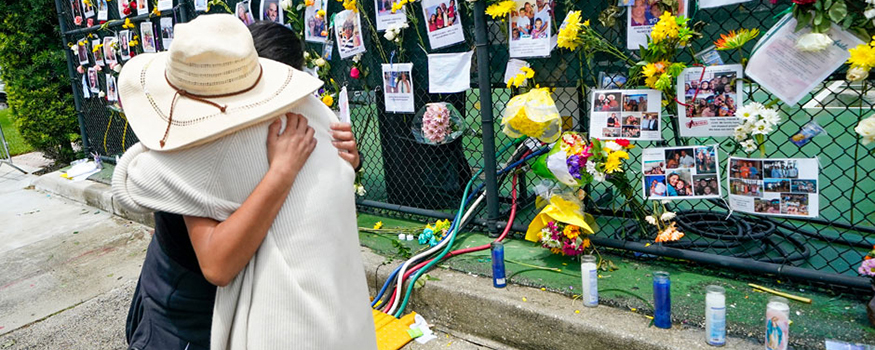Faculty members and a graduate student in the School of Communication—veteran newspeople—share how they cope with covering large scale catastrophes, including the condo building collapse.
The Surfside building collapse of the Champlain Towers South is a tragedy that has captured news headlines nationally and internationally, as search teams continue to comb the rubble for signs of life or extract remains.
As of Wednesday morning, 16 have been confirmed dead, with 147 people still unaccounted for since the collapse, according to the Miami Herald.
Hundreds of news reporters, photographers, and videographers are at the site covering the event daily. But interviewing anguished family members of those who were inside the building when it collapsed and describing the victims’ lives can take an emotional toll on even the most seasoned journalists. How do they prepare for such a task?
Joseph B. Treaster, professor of journalism at the University of Miami School of Communication and a veteran journalist with more than 30 years of news experience, is covering the event as a contributor for The New York Times. He has been reporting on the tragedy since the tower collapsed at about 1:30 a.m. on Thursday, June 24.
“The intensity of the event takes over for me,” Treaster said in a phone interview. “And that acts as a kind of buffer. I am scrambling to find out what happened. I’m talking to people, victims, families, firemen, the police, government officials, anyone I see. I’m concentrating, trying to figure out what happened, getting back to the Times so we can tell the world,” he added. “I know it’s worthwhile and that is part of what drives me.”
Experience helps. During his more than three decades as a foreign correspondent and domestic reporter for the Times, Treaster has covered hurricanes, volcano eruptions, 9/11, earthquakes, and half a dozen wars. “I know it’s important to get in fast, before the barricades are up,” he said. “In the first hours of a disaster everyone is shaken. They’re eager to tell their story. As the days go by, things become more organized and more controlled.”
Treaster has not become jaded by tragedy. Sometimes he blinks back tears. He chokes up. But he noted that he catches his breath, puts his head down, and keeps on marching.
“I cannot tell you how many horrible things I have seen,” Treaster said. “I’ve seen lots of bodies and heard lots of gun fire, and I’ve been terrified many times. But, somehow, I keep going.”
Part of reporting on tragedies, Treaster pointed out, is getting in close, feeling the pain and the loss. “People need to know how bad things are,” he said. “You need details that help people halfway around the world understand the enormity and the depth of the loss. You have to help people see it.”
Maria Alejandra Cardona, a graduate student in the School of Communication, is a freelance photographer who has covered multiple police shootings, California wildfires, and hurricanes. She spent last Thursday at the Surfside collapse site and took several photographs that appeared in The New York Times.
She states that the notion that journalists must put aside their feelings is a flawed concept.
“When the camera is in front of my face it does not mean that I am less human,” she said. “I feel my emotions very deeply in my soul. If you were to look behind my camera, you would see tears on my face.”
But in the face of profound human tragedy journalists also have to show compassion, she said. As she was leaving the scene last Thursday, she stopped by a makeshift memorial near the site and spotted a man lighting candles.
“He would light the candle, then cry,” she said. She took the picture but did not ask the man his name.
“I could not disrupt his moment,” she said. “He needed to take that moment by himself. There are times when you have to step back and other times when you ask a question.”
Boriana Treadwell, a senior lecturer in the School of Communication, spent almost 17 years at CNN working as a writer, producer, and assignment editor. She covered stories including a major tsunami, 9/11, shootings, hurricanes, earthquakes, and the Sandy Hook massacre. As an assignment editor, she often sent correspondents into war-torn countries, organized their coverage, and wrote stories based on what they were reporting.
“There is no way to prepare yourself to deal with these tragedies,” she said. “I always tell my students these are very powerful stories because they are the saddest but the ones that have the most impact.”
During her years at CNN, Treadwell watched war correspondents breaking down once the cameras were off. Others were so impacted by the misery around them that they stepped out of their journalism roles to help, she said. One reporter—Arwa Damon, who had been an international war correspondent for many years—was so devastated by the plight of children in war-torn Syria that she decided to establish a foundation to help those children, Treadwell noted.
“You are a reporter, and you try to stay disconnected but often you can’t because you are human,” said Treadwell. Two stories really affected Treadwell personally: the Malaysian plane that was shot down in 2014 over Ukraine air space and the Sandy Hook massacre of 20 elementary school children.
“I had a friend on that plane, and it really hit me hard,” she said. “With the Sandy Hook massacre, I had a daughter around the same age as those children. It broke me.”
Covering disasters can take a toll, said Treadwell. In her case, after many years in journalism, she decided to leave for the world of academia, training the next generation of correspondents, producers, and photojournalists.







